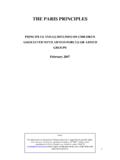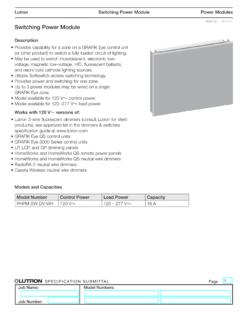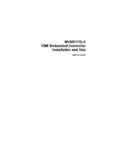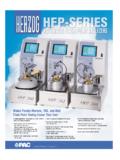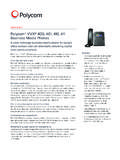Transcription of OTHER MODULES IN THIS COMPANION SERIES: …
1 Sch ool Rea dinessand Transitions United Nations Children's Fund (UNICEF)July 2012 For more information, please contact:Education SectionProgramme Division, UNICEFP ublished by UNICEFDi vision of Communication3 United Nations PlazaNew York, NY 10017, USAW ebsite: : FRIENDLY SCHOOLSCHILD FRIENDLY SCHOOLSOTHER MODULES IN this CFS MANUAL COMPANION SERIES: Climate Change and Environmental EducationWater, Sanitation and Hygiene (WASH) in SchoolsChild Social and Financial EducationA COMPANION to the Child Friendly Schools Manual Contents Acknowledgements ..1 Preface ..21. Purpose, Scope and Concept ..32. Benefits and Costs ..73. Dynamics of Theory in Practice ..104. Location, Design and Construction.
2 145. Family, School, Community ..176. Early Childhood Development Programmes and Schools as Protective Environments ..197. Teachers and School Managers for School Readiness ..218. Monitoring and Evaluation of School Readiness ..22 References ..271 SCHOOL READINESS AND TRANSITIONSThis module was written by Pia Rebello Britto, , Associate Research Scientist at Yale University, and Maria Cristina Limlingan, Ed., of Loyola University in Chicago. Abhiyan Jung Rana, Maida Pasic and Changu Mannathoko from the UNICEF Education Section in New York provided inputs and revisions throughout the drafting process and contributed to its overall quality and , produced and distributed by UNICEF s Division of Communication.
3 Graphic design services were provided by CREATRIX Design FRIENDLY SCHOOLS MANUALPREFACEOver the past decade, the child-friendly schools (CFS) model has emerged as UNICEF s signature means to advocate for and promote quality education for every girl and boy. Child-friendly schools enable all children to achieve their full potential. As a part of a Global Capacity Development Programme on CFS, UNICEF has developed the Child Friendly Schools Manual, a reference document and practical guidebook to help countries implement CFS models appropriate to their specific circumstances. A COMPANION to the Child Friendly Schools Manual, this module provides guidance to policymakers, educators, programme professionals and practitioners on how to promote holistic early learning and development.
4 It can be used in several ways, including: as a resource document for early childhood programmes, preparing children and families for primary school entry; and as an advocacy document for promoting school readiness practices in the transition to the early grades of primary school. It is intended as general guidance adaptable to particular contexts and READINESS AND TRANSITIONS1 PURPOSE, SCOPE AND CONCEPT1 BackgroundThrough a combination of international development frameworks such as the Millennium Development Goals (MDGs), the Education for All (EFA) goals and the World Fit for Children (WFFC) targets, countries are working towards a society in which all children will complete primary or basic education at a As more children enter school, however, it is apparent that many of them are enrolling too late or too early, repeating grades, dropping out or failing to As a consequence, educational disparities are increasing.
5 In light of these trends, the following three questions must be answered:1. Are children entering school with the social and cognitive skills and competencies needed to achieve success in school?2. Are schools equipped and ready to provide optimal learning environments for children?3. Are families and communities ready to help their children make smooth transitions to school? School readiness is the foundation of equity and quality education. It is gaining global support as a viable means to help young children reach their full developmental potential and engage in lifelong learning. School readiness is linked to improved academic outcomes in primary and secondary school and positive social and behavioural competencies in adulthood.
6 While adhering to UNICEF s human rights-based focus on the individual benefits of education, school readiness also builds human capital to address economic s major effort to achieve school readiness is the CFS model, which was launched as a systemic strategy to achieve MDG 2 universal access to and completion of primary school by 2015. School readiness is an important component of the child-friendly strategy. When children and families are prepared for school and schools are prepared for them, children are more likely to enrol in school on time and stay until they complete primary school readinessMany definitions and conceptualizations of school readiness have been used in past decades; however, with recent advances in science and knowledge a growing consensus on the definition has emerged.
7 School readiness is currently defined by three interlinked dimensions: a) ready children; b) ready schools; and c) ready families. Children, schools and families are considered ready when they have gained the competencies and skills required to interface with the OTHER dimensions and support smooth transitions. For example, the child transitions to school, the school transitions to accepting new children into Grade 1, and the families transition to sending their children to school on time and interacting with the school. These three dimensions and characteristic features are 4 CHILD FRIENDLY SCHOOLS MANUAL illustrated on page 5 and described in more detail below:a. The ready children dimension focuses on children s learning and development.
8 It refers to what children should know and be able to do in order to enter school ready and eager to learn, thereby enabling a successful transition to a primary school learning Success in school is determined by a range of behaviours and abilities, such as literacy, numeracy, ability to follow directions, working well with OTHER children and engaging in learning These behaviours and abilities are interrelated across broad domains of development and learning, including physical well-being and motor development; social and emotional development; approaches to learning; language development; cognition and general knowledge; spiritual and moral development; appreciation for diversity and national pride.
9 Children s readiness for school addresses all children, especially the economically disadvantaged and the vulnerable, including girls, children with disabilities, ethnic minorities and children living in rural areas. There is a particular emphasis on equity in achieving MDG The ready schools dimension focuses on the school environment. It includes practices that: a) foster and support a smooth transition for children to primary school and beyond; and b) promote learning for all children. Ready schools characteristically create continuity and maintain learning expectations for children between early learning and primary school environments. OTHER important quality characteristics include the practices schools use to bridge the cultural divide between home and The divide is greatest for children whose first language is not the same as the language of school instruction.
10 Schools can bridge this gap by working with parents and incorporating culturally responsive practices that include the use of the child s first language. this practice promotes equity by including traditionally disadvantaged ethnic With respect to children with disabilities, ready schools adopt inclusive approaches in lieu of exclusionary educational practices and discriminatory In general, the dimension of ready schools includes the overall quality of the school environment evidenced in such characteristics as sufficient class time devoted to learning; adequate supply of learning materials such as books and teaching aids; and effective teaching, pedagogic practices and teachers The ready families dimension focuses on parental and caregiver attitudes and involvement in their children s early learning, development and transition to school.


